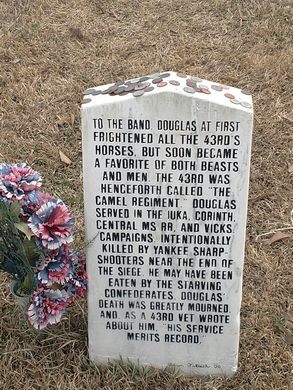Memorial Day is a federal holiday in the US for honoring and mourning the U.S. military personnel who have died while serving in the US Armed Forces. It is observed on the last Monday in May.
Among the numerous cemeteries where these brave personnel have been laid to rest, there is a cemetery in which a grave marker pays tribute to an unlikely veteran — a camel.
While images of camels are not normally associated with the Civil War, one such animal found its way into a Mississippi unit, and into history.
Douglas, also known as Old Douglas, was a dromedary (one hump) camel, who was part of the 43rd Mississippi Infantry, Company A, nicknamed The Camel Regiment. His grave marker is among the 5,000 markers for Confederate soldiers in the Soldier’s Rest section of Cedar Hill Cemetery in Vicksburg, Miss.

No one is sure how Douglas ended up in the 43rd Infantry, but he became soon became their mascot and was often referred to as “faithful” and “patient.” He served his unit well, carrying supplies and knapsacks for the soldiers.
According to his grave marker, he is said to have been given to Colonel W.H. Moore by 1st Lt. William Hargrove of Company B, but how he got to Mississippi in the first place or got into the possession of Hargrove is a mystery.
Douglas participated in the Battle of Iuka under Major General Sterling Price and in the Battle of Corinth under Major General Earl Van Dorn. Sadly, he was killed by a Union sharpshooter on June 27, 1863, during the siege of Vicksburg.
According to legend, after Douglas was killed, the Union army made a meal out of him since food was scarce, and then they made souvenirs out of his bones and scattered them around. In retaliation, the Confederate Army sent its six best snipers to shoot the soldier who killed Douglas. It’s also believed that Douglas was eaten by the starving soldiers of his own unit, at least that’s what his grave marker indicates. But who really knows?
So considering that camels aren’t indigenous to the US, how did a camel even get involved in the Civil War?
In the 1840s, during the exploration of the American West, Jefferson Davis was a big proponent of starting a US Camel Corps to use camels as an alternative to horses and mules who were dying of dehydration since they could carry heavy loads for long distances with little water and could better withstand the brutal heat. In 1855, Davis got approval for the project, as well as money to purchase camels. Unfortunately, the camels were found to be difficult to work with, and often spooked other animals, sometimes injuring them. By the time the Civil War started in 1861, the US Camel Corps was all but forgotten. Many of the camels were sold to private owners while others escaped into the desert throughout the West. Some of these camels eventually found their way into the Civil War.
While Douglas may be the only camel known to have his own memorial gravestone, he, along with other camels who served in the war, haven’t been forgotten. In 1997, the Texas Camel Corps was created by Doug Baum who travels the state with his camels, giving rides and putting on historical reenactments to educate people about the unique part camels played in opening up of the American West. The Corps also promotes the camels’ participation during the Civil War with reenactments, and it’s said that two of the camels used in the reenactments are descendants of Old Douglas.
Douglas’ story is described on both sides of his grave marker and leaves no doubt of how beloved he was by his unit. It also leaves no doubt that he is justifiably deserving of a marker in the cemetery, as evidenced by the last line of his epitaph which reads: “And, as a 43rd vet wrote about him, ‘his service merits record.’”
Cedar Hill Cemetery is located on Sky Farm Avenue, Vicksburg, MS. Hours are daily from 7:30 until dusk. The cemetery is gated after hours. (Note: local health policies may affect hours and access)
Directions: I-20 exit 4A or 4B. Drive west on Clay St. for one mile. Turn right onto Mission 66. Drive north one mile. Turn right onto Sky Farm Ave. Drive a quarter-mile. Turn first left into cemetery (Gate 2). Drive a few hundred feet. Just before you get to the second possible left turn within the cemetery, look to the left where you’ll see a small group of Confederate tombstones. Douglas’ grave marker is on the right side of that group, second row in. There is a metal pole with a camel on top placed beside the gravestone.